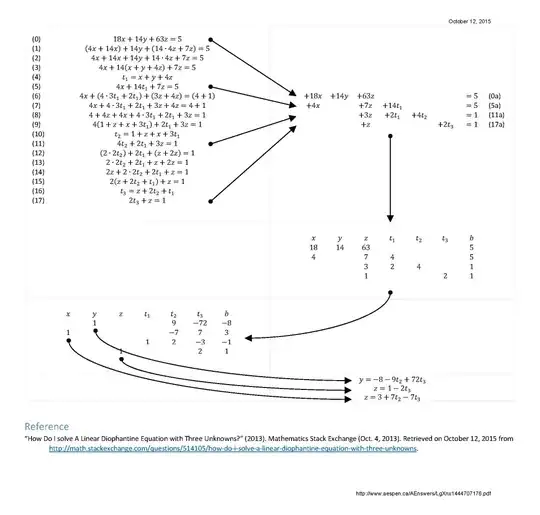Hint $\ \color{#c00}{18\!-\!14}\,\mid\, 63\!+\!1 $ $\, \Rightarrow\,\overbrace{16\,(18\!-\! 14)-63 = 1}^{\textstyle 18x + 14y + 63z = 1}.\,$ Scale that by $\,5\,$ to get $\,d=5\,$ on RHS.
Remark $\ $ The idea is simply to search for a "small" linear combination $\,n = \color{#c00}{ia+jb}\,$ of two elements $\,a,b\,$ of $\,\{14,18,63\}\,$ such that the 3rd element satisfies $\ c\equiv \pm1 \pmod n,\,$ hence $\, \pm1 = c+kn = c + ki\,a + kj\,b\,$ thus scaling by $\pm d\,$ yields $d$ as a linear combination of $a,b,c.\,$ Above the first "small" number we see is $\, n = \color{#c00}{18\!-\!14} = 4\,$ works since $63\equiv -1\pmod {\!4}.\,$ Notice that we could replace $\, k = \pm1\,$ by any divisor of $\,d,\,$ then scale by $\,d/k\,$ to get $\,d\,$ on RHS.
The reason for choosing $n$ "small" is that this increases the probability that $\,c\equiv \pm1\pmod{\! n},\,$ e.g. $100\%$ chance if $n = 2,\,$ $67\%$ if $n = 3.\,$ We know (by Bezout) that the smallest such $n$ is $\,\gcd(a,b)\,$ but - as we saw above - often simpler choices work such as $\,b-a.$
Below we will see that the above optimization works when the extended Euclidean algorithm terminates in a couple steps.
Algorithmically, using the Extended Euclidean Algorithm to compute $\rm\,gcd(63,18,14) = 1\,$
$$\begin{array}{rrr}
[1]&\ 63& 1& 0& 0\\
[2]&\ 18& 0& 1& 0\\
[3]&\ 14& 0& 0& 1\\
[2] -[3]\, =\, [4]& 4& \!\!0& 1& -1\\
16[4] -[1]\, =\,[5]& 1& -1& 16& \!\!\!\!-16
\end{array}\qquad\qquad\qquad\quad$$
where the row $\ n\,\ a\,\ b\,\ c\,\ d\ $ denotes that $\ n = 63a + 18 b + 14 c.\ $ Thus the final row yields
$$\quad 1 = -63 +16(18) - 16(14)$$
See here for another worked example, and see here for an explicit formula for the general trivariate linear Diophantine equation (in terms of solutions of associated bivariate equations).
